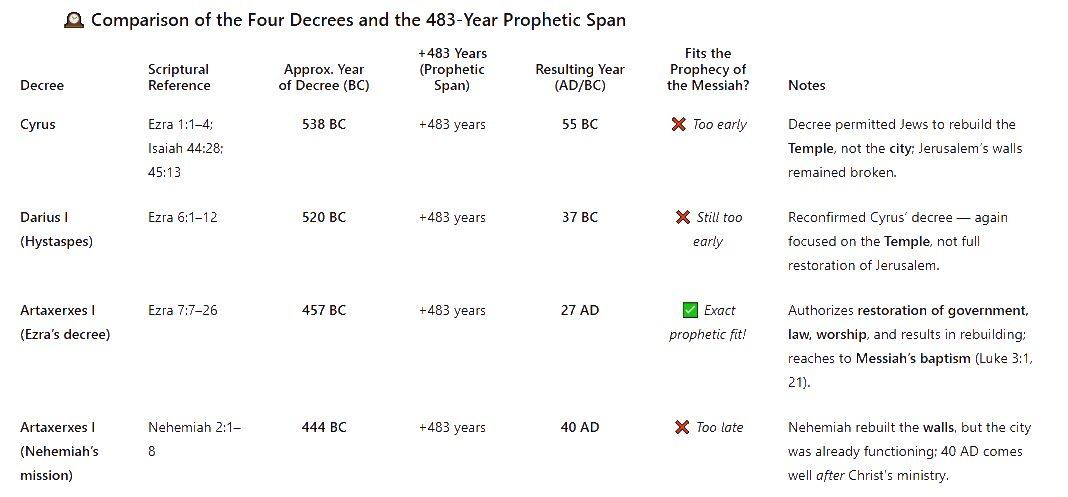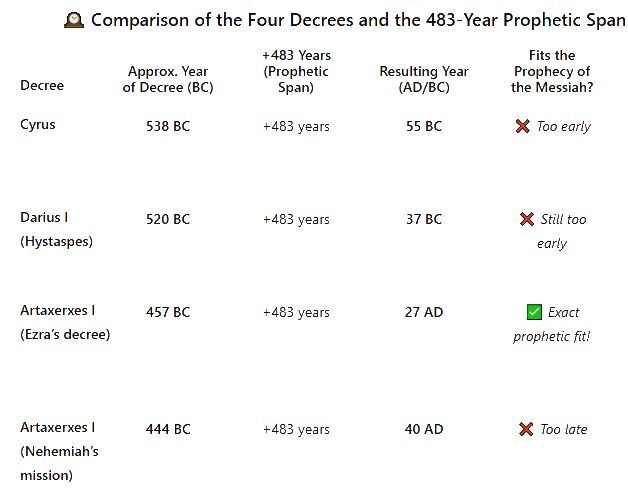
A question for you: Which decree was the decree to “restore and build Jerusalem”? For centuries, scholars have debated this question. Modern commentators often point to Nehemiah’s time, suggesting that his mission to rebuild Jerusalem’s walls marks the decree mentioned in Daniel 9:25. But was that truly a decree? Meanwhile, Adventist scholars have long identified the decree of Artaxerxes in Ezra chapter 7 as the starting point for both the 70-week and 2300-day prophecies. Yet even here, one question remains: Where does that decree actually say to build Jerusalem? In this article, we’re going to uncover the Bible’s answers to all these questions like you've never seen before.
The Prophetic Context: The Starting Point
Adventists understand that both the 70-week and 2300-day prophecies share the same starting point. Gabriel revealed this starting point to the prophet Daniel when he said, "Know therefore and understand, that from the going forth of the commandment to restore and to build Jerusalem unto the Messiah the Prince shall be seven weeks, and threescore and two weeks" (Daniel 9:25).
But what command was this?
The book of Ezra mentions three royal decrees, and Nehemiah adds a fourth instance that is often referenced as a decree. All of them refer to Jerusalem in some way or another. So the question we must now answer is which one fulfills Daniel’s prophecy?
Testing the Timing
The prophecy says that from the command to restore and build Jerusalem “unto the Messiah the Prince would be seven weeks and sixty-two weeks” — a total of 483 days (Daniel 9:25). If we apply the day-for-a-year principle (Numbers 14:34; Ezekiel 4:6), those 483 prophetic days equal 483 literal years. So all we have to do is examine each decree and find the one that was issued 483 years before the time of Christ. Let's review the chart below for comparison:
When we examine the above decrees, we can clearly see that there's only one decree that is correctly timed. The 457 BC decree was issued 483 years before Christ's anointing by the Holy Spirit.
This should be an open and shut case, but many students of prophecy have realized that something pivotal is missing from Artaxerxes' first decree. Many have realized that there is no language that refers to the building of Jerusalem.
The Missing verbiage
When we read Ezra 7:11–26, we see strong references to restoration — the appointment of judges and magistrates, the reestablishment of civil order, and worship in the temple. All these represent restoration. However, there is no explicit command to rebuild the city itself. As a matter of fact, if you examine all four decrees, you will discover that none of them reference the rebuilding of Jerusalem.
If none of the decrees mention “rebuilding Jerusalem,” then why do we still identify Artaxerxes’ 457 BC decree as the one that fulfills Daniel’s prophecy? To answer that, we must look deeper at Gabriel's words to Daniel:
The Going forth of the command
Daniel 9:25 says:
“Know therefore and understand, that from the going forth of the commandment to restore and to build Jerusalem…”
That phrase “going forth” is critical. In Hebrew, it’s מוֹצָא (motsa), a noun meaning source, origin, or result. It is not the common verb יָצָא (yatsa), which Gabriel used when he said, "At the beginning of thy supplications the commandment came forth." Because Gabriel used motsa, we can conclude that Gabriel wasn't referring merely to the action of the decree being issued or even when the decree was issued, but rather when the command went into effect.
An example of this is Deuteronomy 8:3, which uses this same word when it says, “Man shall not live by bread alone, but by every word that proceedeth [motsa] out of the mouth of the Lord.” The focus is not just on God's Word, but the result that God's Word produces. So too, Daniel 9:25 points not necessarily to the date the decree was written, but to when it produced its result or went into effect.
Ellen G. White bluntly expresses this idea in the book, Christ in the Sanctuary (p. 84). Here's what she wrote:
“The decree of Artaxerxes went into effect in the autumn of 457 BC.”
However, according to Ezra 7:9, we know the decree was given in the spring that year:
“For upon the first day of the first month began he to go up from Babylon, and upon the first day of the fifth month came he to Jerusalem…”
The Jewish first month corresponds roughly to March or April, and the fifth month would be August or September. Therefore, the decree was issued in the spring, but went into effect in the fall, when Ezra arrived in Jerusalem and implemented it. That “going forth” — motsa— marked the real beginning of the prophecy.
Why the Decree Doesn’t Mention Rebuilding
If the decree doesn’t explicitly say “rebuild the city,” how could it still fulfill Daniel’s prophecy? The key is found in Ezra 4. Earlier in Artaxerxes’ reign, Israel’s enemies wrote a letter to him, warning that the Jews were “building the rebellious and evil city” (Ezra 4:12–13). Fearing insurrection, Artaxerxes issued a decree forbidding Jerusalem’s rebuilding when he responded, "Give ye now commandment to cause these men to cease, and that this city be not builded, until another commandment shall be given from me." (Ezra 4:21).
It's important to realize that Artaxerxes wrote this decree before the 457 BC decree. Why? Because, according to the law of the Medes and Persians, once a king issued a decree, not even he could reverse it! (see Daniel 6:8, 15 and Esther 8).
Subsequently, Artaxerxes, showing favor towards Ezra and having seen through the false accusations hurled at his people, became impressed that the Children of Israel should continue building the city. However, there was one problem— Artaxerxes couldn't legally reverse his earlier decree. So what did he do? He issued a new decree — carefully worded — full of ambiguous phrases like:
Whatever seems good to you and your brethren to do… do it according to the will of your God. (Ezra 7:18)
And whatever else is required for the house of your God, which it falls to you to provide, you may provide it out of the king’s treasury. (Ezra 7:20)
Whatever Ezra the priest, the scribe of the Law of the God of heaven, requires of you, let it be done with all diligence. (Ezra 7:21)
Whatever is commanded by the God of heaven, let it be diligently done. (Ezra 7:23)
This allowed the Jews, under Ezra’s leadership, to interpret the command as granting full authority to restore and rebuild Jerusalem, while simultaneously giving the king legal cover should anyone accuse him of contradicting his own law.
Thus, after Ezra arrived in Jerusalem in the fall, then and only then could the decree go into effect.
the rebuilding in scripture
Ezra organized leadership, reformed worship, and motivated the people to rebuild the city. We know this because in Ezra 9:9, he acknowledges:
For we were bondmen; yet our God hath not forsaken us in our bondage, but hath extended mercy unto us in the sight of the kings of Persia, to give us a reviving, to set up the house of our God, and to repair the desolations thereof, and to give us a wall in Judah and in Jerusalem..”
Ezra’s mention of “repairing desolations” and “giving a wall” indicates the process of restoration and rebuilding — the very result (the motsa) Daniel had foretold.
Conclusion: A Decree of Restoration and Rebuilding
Though the word “build” never appears in Artaxerxes’ decree, its result was both restoration and rebuilding.
By the king’s order — and Ezra’s faithful leadership — Jerusalem’s civil government, worship, and physical city were restored.
The prophecy of Daniel 9:25 was not fulfilled by the words written on parchment alone, but by the divine result that went forth from that command — the motsa that changed history. And thus, the decree of Artaxerxes in 457 BC stands confirmed as the decree “to restore and build Jerusalem,” marking the starting point of the 2300-year prophecy.



